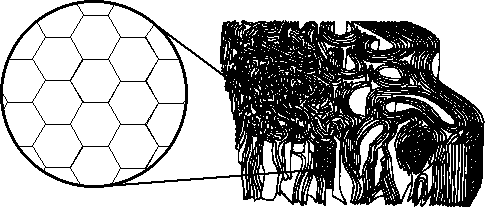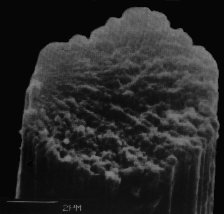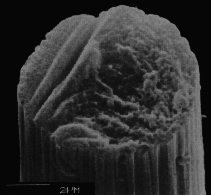Carbon Fibre
|
CHEMISTRY
|
Carbon Fibre
Carbon Fibre is one of the most recent developments in the field of composite materials. The development of composites has come about following the realization that by binding synthetic fibres together with various resins, very light, strong and durable materials could be made. Carbon fibre was originally developed in space technology, but has now been adopted in many other areas of manufacture. With the decrease in its cost over recent years, it is fast becoming one of the leading materials in many areas, including performance sport equipment, transport, scientific experiments and even wallets and watches!. Several uses of carbon fibre are discussed in the Uses section of this site and further information can be found in the links section.
Carbon fibre is composed of many featherweight strands, containing mainly carbon, usually embedded in an epoxy resin. There are many different grades of carbon fibre available, with differing properties, which can be used for specific applications.
To give an idea of some of the useful properties of carbon fibre, a table comparing it to steel is shown below :-
| TENSILE STRENGTH | DENSITY | SPECIFIC STRENGTH | |
| CARBON FIBRE | 3.50 | 1.75 | 2.00 |
| STEEL | 1.30 | 7.90 | 0.17 |
As can be seen, carbon fibre has a tensile strength almost 3 times greater than that of steel, yet is 4.5 times less dense.Carbon fibre is composed of many featherweight strands, containing mainly carbon, embedded in a resin. there are many different grades of carbon fibre available, with differing properties, which can be used for specific applications. Below is a table which gives details on some of the properties of various grades of carbon fibre :-
| TENSILE STRENGTH | TENSILE MODULUS | |
| HIGH TENACITY | 4.00 | 240 |
| ULTRA HIGH TENACITY | 4.80 | 240 |
| INTERMEDIATE | 6.00 | 290 |
| HIGH MODULUS | 3.50 | 375 |
| ULTRA HIGH MODULUS | 3.40 | 425 |
| HIGH MODULUS / TENACITY | 3.90 | 400 |
Other desirable physical properties of carbon fibre and other composites include its resistance to corrosion, fire and high stress tolerance levels as well as its chemical inertness. It is difficult to get an idea of the exact structure of individual carbon fibres, but X-Ray crystallography has provided an idea of what a very small piece of carbon fibre looks like and strangely enough it is virtually identical to graphite :-
This is a very strange thing to find, seeing as graphite is fairly soft and flakey, whereas carbon fibre is strong and requires large forces to fracture. The structure does however explain a few similarities between the two in that they are both brittle and, importantly, both are chemically inert and therefore unreactive. It also explains how at very high temperatures of 2500oC, carbon fibre can be directly converted into graphite. The major differences between the two can be explained by looking at their structures, not at an atomic scale, but at how the individual strands / sheets are arranged. In graphite, large layers of the structure above lie one on top of the other, with weak interactions between the layers. In carbon fibre however, they do still lie one on top of the other, but are less ordered. Basically, the sheets fold within an individual fibre :-

Image from http://www.chem.wisc.edu Used without permission
This is the main, crucial difference between the two and can be used to explain why carbon fibre can be converted into graphite. The reason is that graphite is a much more ordered structure, so is energetically more stable.Production Of Carbon Fibre
Before going into how carbon fibre is manufactured, it is worth looking at the 2 major types that can be produced. Carbon fibre can be either PITCH or PAN based. PITCH based fibres do not have as great strength, lightness or mechanical properties as PAN based fibres, so are less commonly used. The raw material for PAN based fibres is polyacrylonitrile, which is commonly prepared using the Sohio process. Up until the 1960's / 70's, it was normally prepared from acetylene and HCN (Hydrogen Cyanide, but apart from the fact that HCN is incredibly toxic to humans, a yield of only 60 - 65% was obtained. The Sohio process was invented by the Standard Oil Company, Ohio in 1960 and involves an amonoxidation reaction between propene and ammonia :-

The Sohio process improved upon the earlier one in several respects, namely that it dramatically increased yield, produced less waste gases and water and was generally more energetically, economically and environmentally efficient. Polymerisation of the product then give polyacrylonitrile, a long chain polymer :-Once this polymer has been produced, the manufacture of carbon fibre can proceed. The first step of the process is to stretch the polymer so that it is parallel to what will eventually become the axis of the fibre. Once this has been done, the polymer is oxidised at 200-300oC in air, which removes hydrogen and adds oxygen to the molecule and forms the basis of the hexagonal structure seen above :-
During this process, there is a colour change from the white chain polymer to the black ring polymer. The polymer produced here is very high melting point and now has to be purified. To do this, a process called Carbonisataion is used. This involves heating the polymer in a nitrogen rich environment, which expels impurities in the chain as volatile by products, which are removed, until the polymer contains 92 - 100% carbon, depending on the quality required for the fibre. temperatures ranging from 1000 - 2500oC are used, depending on the desired properties required in the fibre.
Each of the fibres produced is about the fifth of the width of a human hair.
The final stages in the production of carbon fibre involve weaving the fibres into sheets or tubes and embedding them in an epoxy resin. There are several different patterns of weave, including plain, satin, twill or basket weave, again giving the fibres customizable properties. The final stage of embedding in a resin is known as sizing and forms the final composite which is then ready for further processing to form a variety of products (see Uses section).Development of new fibres
An important area of scientific research is the development and refinement of carbon fibre technology. One way in which this is done is by fracturing or breaking the fibres and looking at what has happened. The 2 photos below show microscopic pictures of a) a carbon fibre tensile failure and b) flexural failure (fibre is compressed along its axis).


By analysis the areas where these fractures have occurred, it is possible to identify individual characteristics of the fibres which have allowed the failure to have occurred. It is then possible to remove these characteristics and therefore produce stronger fibres. For example, on image b, the straight lines in the plane of the fracture have been linked to that particular part of the fibre having a structural arrangement very similar to that of graphite, i.e. layer upon layer with little folding.
Another useful tool for this kind of work is X-Ray diffraction, which allows detailed analysis of the atomic arrangements within the fibres.
![]()
![]()
E-Mail : mj0535@bris.ac.uk